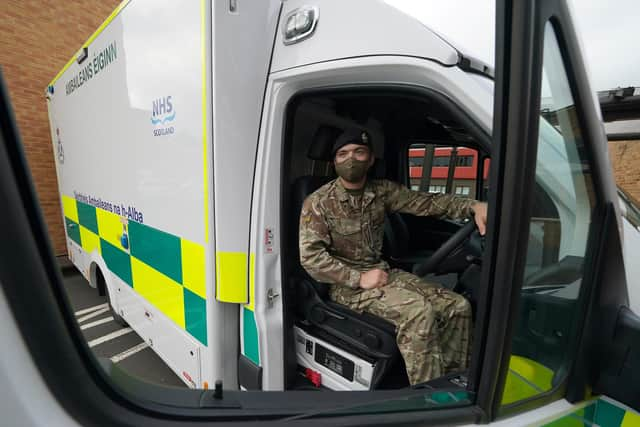Covid Scotland: Plans to manage Omicron pressure on ambulances branded 'unsafe'
It comes as the Scottish Government announced that a further 90 military personnel will support the NHS in January and February, expected to be the busiest months of the year.
In a bulletin circulated to staff this week, the Scottish Ambulance Service (SAS) proposed measures including splitting additional crews and asking staff to work with one rest break rather than two.
Advertisement
Hide AdAdvertisement
Hide AdWhile these conditions have already become reality for some crews, the GMB union warned the new measures would “make a bad situation worse”.


Under the new plans, additional crews would be split, meaning more ambulances would be operated by one trained clinician and one driver, including military drivers.
Some ambulances would be staffed by trainee ambulance workers paired with military drivers, meaning the crew would not be able to respond to the most urgent cases or drive under “blue light” conditions.
The GMB union warned the plans were “unsafe” and risked “making a bad situation worse”.
One ambulance worker, who did not wish to be named, labelled the measures “unsafe for staff welfare and patient safety”.
"Students technicians are being paired with army drivers,” the worker said. "Student technicians can’t work unsupervised and can only transport patients to hospital.”
The worker said military drivers were not qualified to use blue lights and are not clinically trained.
In cases where a patient needs to be urgently brought to hospital but neither member of the crew is trained in “blue light” driving, the SAS said another ambulance could be called as back up.
Advertisement
Hide AdAdvertisement
Hide AdA spokesperson for the GMB union said the plans were a “safety concern”, adding “not just for staff, but also for the provision that's being put on for the public”.
The spokesperson said: “Staff are already exhausted. They have been working in a state of fear for the last two years, and given the conditions that they are constantly being asked to undertake, they are also getting increasingly angry.”
A spokesperson for the Scottish Ambulance Service said: “As this staff bulletin makes clear, robust plans must be in place to protect essential services to the public if we experience extreme pressures and potential staff absence in the coming weeks, due to the threat posed by the Omicron variant.
"The additional measures are for these times of extremis only and we’ve been engaging closely with trade unions in considering these options. Hopefully these measures will not be needed.”
A Scottish Government spokesperson said: “The ambulance service has been clear that staff will only be asked to work differently when circumstances are considered extreme, due to staff absence or a significant increase in demand.
“The Covid-19 pandemic has been the biggest shock the NHS has suffered in its 73-year existence and has heaped pressure on our ambulance service and wider NHS."
The Scottish Government announced that a further 90 military personnel will be brought in to support Scotland’s NHS from January 7.
NHS Grampian will receive 38 personnel for four weeks, while 32 will work in Lanarkshire for four weeks, and 20 in Ayrshire and Arran for six weeks.
A message from the Editor:
Thank you for reading this article. We're more reliant on your support than ever as the shift in consumer habits brought about by coronavirus impacts our advertisers.
If you haven't already, please consider supporting our trusted, fact-checked journalism by taking out a digital subscription.
Comments
Want to join the conversation? Please or to comment on this article.
